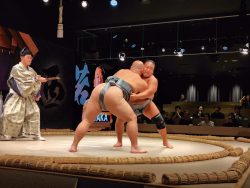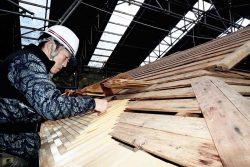
A statue of a sumo wrestler is seen on the grounds of the Sumo Shrine in Sakurai, Nara Prefecture.
19:09 JST, February 19, 2021
NARA — About 2,000 years ago, a clash between two men boasting of their strength became the origin for what would be regarded as the national sport and hold an important place in traditional culture.
From that duel evolved the sport of sumo.
It is said to have all started on the grounds of the Sumo Shrine in Sakurai, Nara Prefecture, which has become a place for sumo fans to pay their respects.
Present-day yokozuna, or grand champions, visit to occasionally perform the traditional ring-entering ceremony, and a monument was recently erected to honor the first grand sumo tournament victory of Tokushoryu, a wrestler from the prefecture.
The Sumo Shrine is located on the northwestern foot of Mt. Miwa, which has been revered since ancient times as a sacred mountain. The shrine sits in a serene environment with sunlight spilling through the trees. Amid the serenity, the new, massive monument cuts quite a figure.
Tokushoryu’s victory at last year’s New Year Grand Tournament made him the first wrestler from the prefecture to win a championship in 98 years. More notably, he accomplished the feat as the lowest-ranked wrestler in the upper-most makuuchi division. The total cost of the monument, about ¥600,000, was covered by donations from Sakurai residents. An unveiling ceremony was held in October last year, with Tokushoryu participating online from Tokyo.
“Because of the coronavirus, it was impossible to hold a big unveiling ceremony, but quite a few fans have already come to see the monument,” said Hidejiro Shimaoka, 80, a member of a group working to revitalize the area by publicizing the shrine. “I hope it provides an opportunity for more people to know about the place where sumo originated.”

A monument commemorating the 2020 grand sumo tournament victory of Tokushoryu, left, and a monument that honors Nomi no Sukune, a wrestler from ancient times, stand on the grounds of the Sumo Shrine in Sakurai, Nara Prefecture.
1st Imperial spectator
There are many theories about the origins of sumo, but Sakurai provides a strong case as it was the location of the first bout watched by an emperor.
Nihon Shoki, a chronicle of Japanese history completed in the 8th century, records that two men — Nomi no Sukune from Izumo (present-day Shimane Prefecture), and Taima no Kehaya from a village in what is now Katsuragi, Nara Prefecture — competed in a test of strength on July 7 in the seventh year of the reign of the 11th emperor, Suinin, around 23 B.C.
It is unknown when the Sumo Shrine was established, but it enshrines Nomi no Sukune, the winner of the bout.
Centuries later in 1962, major figures of the Japan Sumo Association made a pilgrimage to the shrine for a festival to honor the birthplace of sumo, led by then chairman Tokitsukaze and yokozuna wrestlers Taiho and Kashiwado, who performed the dohyo-iri ring-entering ceremony.
However, after the boom created by two yokozuna brothers Takanohana and Wakanohana faded, sumo’s popularity declined during the Heisei era (1989-2019) and the number of visitors also decreased.
Sumo for kids
In 2013, the shrine once again attracted attention. To help revitalize the local community affected by a declining birthrate and aging society, Shimaoka and others set their sights on utilizing the shrine.
“Compared to Shimane Prefecture and Katsuragi, which both tout themselves as the birthplace of sumo, Sakurai has little name recognition,” Shimaoka said.
In July that year, a section of the grounds of the shrine that had become overgrown with trees and weeds was cleared, and a monument, about 2.5 meters tall and 1.5 meters wide, erected to commemorate Nomi no Sukune.
The following spring, the shrine started a sumo tournament for elementary school children. As the winners in each age group from fourth grade up qualify for the national tournament at Tokyo’s Ryogoku Kokugikan, the Sakurai tournament now draws more than 100 participants every year. Tokushoryu even made an appearance to interact with the kids.
Last year, the kids tournament had to be canceled because of the coronavirus crisis.
“I hope the pandemic will end soon and that the day will come when children can have fun competing in sumo here,” Shimaoka said.
Extend your trip

Signage about the Makimuku Hishiro no Miya palace

Legendary ruins of Makimuku Hishiro no Miya
egend has it that Makimuku Hishiro no Miya, a palace of Emperor Keiko, the 12th emperor, was located near the shrine. A prince named Yamato Takeru no Mikoto was depicted as a hero in such Japanese classics as Nihon Shoki and Kojiki (Record of Ancient Matters), because on the emperor’s orders, he went on expeditions to conquer powerful families in Kyushu and the eastern part of the country who refused to be ruled by the Imperial court.
Related Tags
"Features" POPULAR ARTICLE
-

Students Recreate 19th-Century Bento Boxes Made for Ino Tadataka’s Survey Team in Hot Spring Town on Nakasendo Road
-

Santa Claus Delivers Christmas Presents to Penguins at Aquarium in Japan’s Nagasaki Prefecture
-

Sumo Restaurant in Tokyo Teaches Foreign Visitors About the Ancient Sport, with Bouts Between Retired Rikishi
-

Autonomous Passenger Ship Connects Mainland with Remote Island in Seto Inland Sea; World’s 1st Commercially Operated Autonomous Vessel
-

Osaka’s Sumiyoshi Taisha Shrine Bustles with New Year’s Visitors
JN ACCESS RANKING
-

As Chinese Tourists Shun Japan, Hotels and Stores Suffer
-

Osaka-Kansai Expo’s Economic Impact Estimated at ¥3.6 Trillion, Takes Actual Visitor Numbers into Account
-

Japan Govt Adopts Measures to Curb Mega Solar Power Plant Projects Amid Environmental Concerns
-

BOJ Gov. Ueda: Highly Likely Mechanism for Rising Wages, Prices Will Be Maintained
-

Economic Security Panels Debate Supply Chains, Rare Earths; Participants Emphasize Importance of Cooperation Among Allies



























